Introduction #
The Hoofed Animals dataset is tailored for instance segmentation, semantic segmentation, and object detection tasks, comprising 200 images that collectively feature 714 labeled objects distributed among 6 distinct classes: cow, horse, sheep, along with additional categories like deer, goat, and camel. Notably, this dataset presents a challenge due to the subtle cross-category differences among similar animal categories, making it complex for algorithms to distinguish between them accurately. The animals within the dataset are articulated and non-rigid, appearing at various scales and often partially occluded within cluttered environments, posing additional challenges for effective detection and segmentation.
The hoofed animals dataset is designed to complement currently popular benchmarks, such as Caltech-256 and PASCAL. The major deficiencies of these datasets are that their images typically contain a single, prominently featured object from an object category, and that the categories used significantly differ in appearance and topology. In contrast, the hoofed animals dataset contains very similar categories, and therefore poses a challenge for an algorithm to resolve subtle cross-category differences. Since the animals are similar, they share a number of similar parts (e.g., horses and deer have similar limbs). Also, the animals have category-specific, discriminative subparts which allow for categorization (e.g., only deer have antlers). This makes the dataset suitable for evaluating which inter-category relationships an algorithm is capable of capturing (e.g., similarity in terms of shared parts, taxonomy in terms of shared and unshared parts, etc.). Another increase in complexity over popular benchmark datasets is that each image may contain multiple instances of multiple categories. Other challenges involve the following: the animals are articulated, non-rigid objects; they appear at different scales across the dataset; and may be partially occluded, amidst clutter.
These figures show detection, recognition, and segmentation on the test images shown in (third image; rows 1,3) using the DAG (Directed
Acyclic Graph) learned on the training images shown in the first image. The DAG successfully resolves the subtle differences among the animals, since it learns the subcategories of each of these six that are not shared, namely: camel’s hump and head, cow’s udder and head, deer’s antlers, goat’s beard and horns, horse’s reins, and mane; shown in second image are the parts of the test images in third image that got matched with the non-shared DAG nodes.
Sample training images from Hoofed Animals: each image may contain multiple instances of very similar animals, posing a challenge for cross-category resolvability
Learned discriminative, non-shared subcategories of the target categories.
Masked out are the image parts not occupied by detected instances of target categories.
Summary #
Hoofed Animals is a dataset for instance segmentation, semantic segmentation, and object detection tasks. It is applicable or relevant across various domains.
The dataset consists of 200 images with 714 labeled objects belonging to 6 different classes including cow, horse, sheep, and other: deer, goat, and camel.
Images in the Hoofed Animals dataset have pixel-level instance segmentation annotations. Due to the nature of the instance segmentation task, it can be automatically transformed into a semantic segmentation (only one mask for every class) or object detection (bounding boxes for every object) tasks. All images are labeled (i.e. with annotations). There are no pre-defined train/val/test splits in the dataset. The dataset was released in 2007 by the University of Illinois at Urbana-Champaign, USA.
Here are the visualized examples for the classes:
Explore #
Hoofed Animals dataset has 200 images. Click on one of the examples below or open "Explore" tool anytime you need to view dataset images with annotations. This tool has extended visualization capabilities like zoom, translation, objects table, custom filters and more. Hover the mouse over the images to hide or show annotations.

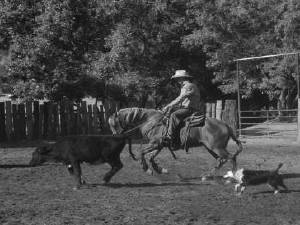

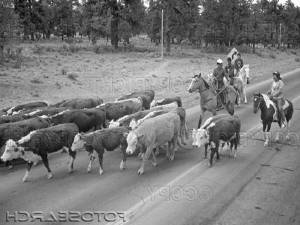

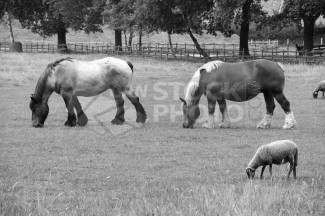

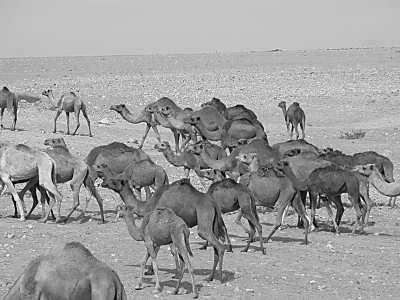

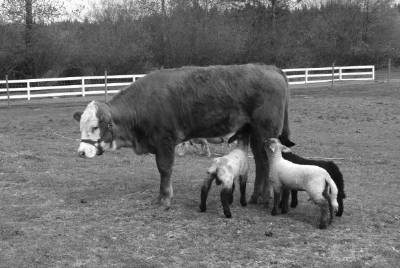

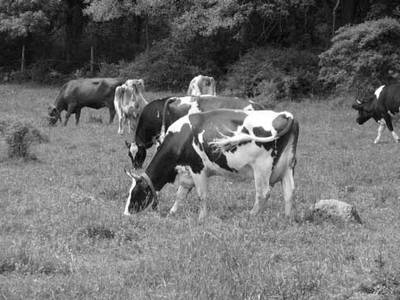

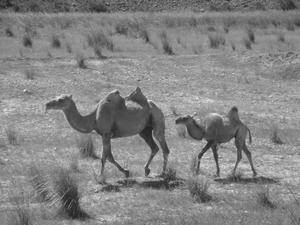

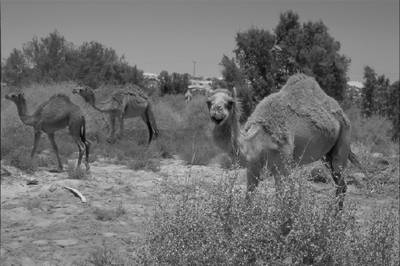

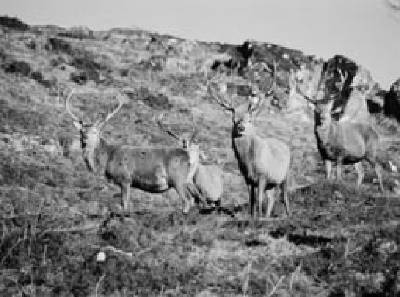

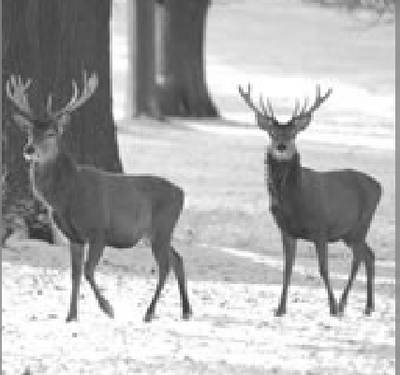

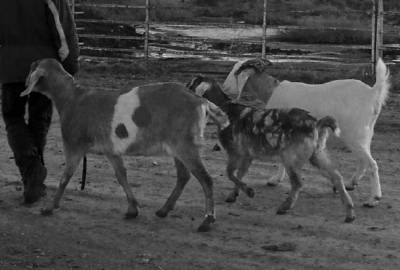


Class balance #
There are 6 annotation classes in the dataset. Find the general statistics and balances for every class in the table below. Click any row to preview images that have labels of the selected class. Sort by column to find the most rare or prevalent classes.
Class ㅤ | Images ㅤ | Objects ㅤ | Count on image average | Area on image average |
|---|---|---|---|---|
cow➔ mask | 63 | 169 | 2.68 | 13.35% |
horse➔ mask | 48 | 89 | 1.85 | 10.82% |
sheep➔ mask | 41 | 135 | 3.29 | 11.84% |
deer➔ mask | 41 | 79 | 1.93 | 17.24% |
goat➔ mask | 39 | 135 | 3.46 | 14.17% |
camel➔ mask | 28 | 107 | 3.82 | 12.94% |
Co-occurrence matrix #
Co-occurrence matrix is an extremely valuable tool that shows you the images for every pair of classes: how many images have objects of both classes at the same time. If you click any cell, you will see those images. We added the tooltip with an explanation for every cell for your convenience, just hover the mouse over a cell to preview the description.
Images #
Explore every single image in the dataset with respect to the number of annotations of each class it has. Click a row to preview selected image. Sort by any column to find anomalies and edge cases. Use horizontal scroll if the table has many columns for a large number of classes in the dataset.
Object distribution #
Interactive heatmap chart for every class with object distribution shows how many images are in the dataset with a certain number of objects of a specific class. Users can click cell and see the list of all corresponding images.
Class sizes #
The table below gives various size properties of objects for every class. Click a row to see the image with annotations of the selected class. Sort columns to find classes with the smallest or largest objects or understand the size differences between classes.
Class | Object count | Avg area | Max area | Min area | Min height | Min height | Max height | Max height | Avg height | Avg height | Min width | Min width | Max width | Max width |
|---|---|---|---|---|---|---|---|---|---|---|---|---|---|---|
cow mask | 169 | 4.98% | 31.14% | 0.35% | 23px | 6.87% | 297px | 81.55% | 97px | 29.48% | 32px | 4.28% | 448px | 89.6% |
sheep mask | 135 | 3.6% | 30.98% | 0.19% | 19px | 6.62% | 344px | 67.08% | 84px | 24.29% | 24px | 4.25% | 493px | 82% |
goat mask | 135 | 4.09% | 26.27% | 0.28% | 21px | 7.4% | 318px | 85% | 122px | 32.76% | 38px | 6.95% | 327px | 79.21% |
camel mask | 107 | 3.39% | 21.95% | 0.31% | 34px | 9.84% | 385px | 82.33% | 118px | 31.91% | 23px | 6.05% | 424px | 79.25% |
horse mask | 89 | 5.84% | 34.64% | 0.48% | 16px | 9.52% | 199px | 80.41% | 108px | 37.26% | 31px | 7.95% | 365px | 84.7% |
deer mask | 79 | 8.95% | 26.93% | 1.21% | 37px | 19.59% | 534px | 95.11% | 155px | 54.56% | 25px | 10% | 608px | 95.08% |
Spatial Heatmap #
The heatmaps below give the spatial distributions of all objects for every class. These visualizations provide insights into the most probable and rare object locations on the image. It helps analyze objects' placements in a dataset.

Objects #
Table contains all 714 objects. Click a row to preview an image with annotations, and use search or pagination to navigate. Sort columns to find outliers in the dataset.
Object ID ㅤ | Class ㅤ | Image name click row to open | Image size height x width | Height ㅤ | Height ㅤ | Width ㅤ | Width ㅤ | Area ㅤ |
|---|---|---|---|---|---|---|---|---|
1➔ | goat mask | 54.png | 274 x 375 | 79px | 28.83% | 107px | 28.53% | 4.25% |
2➔ | goat mask | 54.png | 274 x 375 | 84px | 30.66% | 78px | 20.8% | 3.6% |
3➔ | goat mask | 54.png | 274 x 375 | 113px | 41.24% | 144px | 38.4% | 7.85% |
4➔ | cow mask | 196.png | 336 x 448 | 75px | 22.32% | 116px | 25.89% | 2.23% |
5➔ | cow mask | 196.png | 336 x 448 | 81px | 24.11% | 123px | 27.46% | 3.56% |
6➔ | cow mask | 196.png | 336 x 448 | 69px | 20.54% | 112px | 25% | 3.18% |
7➔ | cow mask | 196.png | 336 x 448 | 92px | 27.38% | 100px | 22.32% | 3.4% |
8➔ | cow mask | 194.png | 694 x 1149 | 159px | 22.91% | 215px | 18.71% | 2.64% |
9➔ | cow mask | 194.png | 694 x 1149 | 148px | 21.33% | 227px | 19.76% | 2.17% |
10➔ | cow mask | 194.png | 694 x 1149 | 188px | 27.09% | 264px | 22.98% | 3.7% |
License #
License is unknown for the Hoofed Animals dataset.
Citation #
If you make use of the Hoofed Animals data, please cite the following reference:
@dataset{Hoofed Animals,
author={Narendra Ahuja and Sinisa Todorovic},
title={Hoofed Animals},
year={2007},
url={https://web.engr.oregonstate.edu/~sinisa/HoofedAnimalsDataset.html}
}
If you are happy with Dataset Ninja and use provided visualizations and tools in your work, please cite us:
@misc{ visualization-tools-for-hoofed-animals-dataset,
title = { Visualization Tools for Hoofed Animals Dataset },
type = { Computer Vision Tools },
author = { Dataset Ninja },
howpublished = { \url{ https://datasetninja.com/hoofed-animals } },
url = { https://datasetninja.com/hoofed-animals },
journal = { Dataset Ninja },
publisher = { Dataset Ninja },
year = { 2025 },
month = { dec },
note = { visited on 2025-12-10 },
}Download #
Please visit dataset homepage to download the data.
Disclaimer #
Our gal from the legal dep told us we need to post this:
Dataset Ninja provides visualizations and statistics for some datasets that can be found online and can be downloaded by general audience. Dataset Ninja is not a dataset hosting platform and can only be used for informational purposes. The platform does not claim any rights for the original content, including images, videos, annotations and descriptions. Joint publishing is prohibited.
You take full responsibility when you use datasets presented at Dataset Ninja, as well as other information, including visualizations and statistics we provide. You are in charge of compliance with any dataset license and all other permissions. You are required to navigate datasets homepage and make sure that you can use it. In case of any questions, get in touch with us at hello@datasetninja.com.


